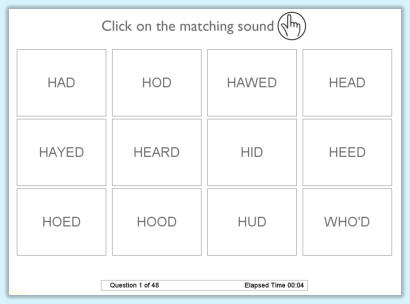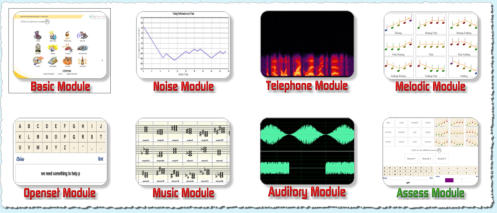

Angel Sound™ is an open platform for auditory rehabilitation. With simple configuration, Angel Sound can be
used for different language (such as English, Chinese, and Japanese etc), different sound materials (pure
tones, environmental sounds, words, sentences, music etc) and different listening environments (quiet,
noise). There are one basic module and six advanced modules in Angel Sound according to the features of
different sound materials and training requirements. The feature of these modules is shown as follows:
1.
Basic module: Basic module targets very broad range of training tasks, including pure tone
discrimination (basic frequency resolution), environmental sounds, voice genders, vowel, consonant,
words, and sentence recognition. This module is suitable for new cochlear implantees and hearing aid
wearer so they have the chance to familiarize with all kind of sound materials and basic discrimination
and identification task.
2.
Auditory resolution module: Auditory resolultion module is a special module targeted at improving the
ability to detect the sutble difference among sounds differed in one specific dimension, such as
frequency, temporal, and/or amplitude. Such discrimination ability is the foundation for higher-level
speech (phoneme, word, or sentence) recognition. Auditory resolution module is suitable for all users.
3.
Telephone speech recognition module: This module is exactly same as the basic module except that
all the sound materials are bandlimited to the frequency range of telephone speech (300-3200 Hz).
After familiar with the basic module, anyone who is interested at improving telephone conversation can
try this module.
4.
Melodic contour identification module: This is a simple music module which is targeted at melodic
contour identification. The difficulty is controlled by semitone between notes and this module also
provides midi sounds from several different instruments. Anyone who is interested at improving music
appreciation should try this module first.
5.
Adaptive speech in noise module: This is an advanced module. In general, the user should perform
better than 80% in quiet condition before using this module. All the tasks in this module are using
adaptive approach, where the noise level will be adjusted according to the users’ response. In general,
this module is suitable for good-performing users.
6.
Comprehensive music module: This is an advanced music module which is targeted at various
aspects of music appreciation, including basic note discrimination, melodic contour identification,
melodic sequence recognition, chord recognition, polyphonic contour identification etc. Many tasks are
very difficult so this module is generally suitable for good-performing users.
7.
Openset recognition module: Most speech conversation is generally openset since the listeners do
not know the contents or chocies what the speakers are talking. Openset recognition module is
attempted at mimicking the real-life conversation where the user has to recognize the sentences or
words without knowing the intended contents or choices by the speakers. In general, this module is
relatively difficult and suitable for good-performing users.
The first step of using Angel Sound is to select an appropriated training module based on individual speech
recognition performance. While an appropriate training module according to individual performance should
be selected, any module can be selected regardless of speech recognition performance. For example,
adaptive speech in noise module or comprehensive music module can be selected even for the poor-
performing users. Also, the users are recommended to switch to different module periodically for better
attention.


Each training group has its own testing task. Once selecting a training group (such as vowel recognition
group in basic module), five different task buttons will be shown in the screen.
Click the TEST button, the program will perform the correspoding speech recognition test according to the
training group. For example, vowel recognition test is shown as follows:
After the test, your speech recognition score will be shown in the screen. According to your recognition score,
the program will automatically recommend the appropriate training level in this training group by adding a
green line under the recommended training level. For example, if your vowel recognition score is 70%, then
the program will recommend you to start the training at level 4 (one green highlighter under level 4 button).
The higher the recognition score, the higher recommended training level. Therefore, it is important to perform
the test periodically to make sure to have appropriate training level. While the program provides its own
recommendation based on perset criteria, you are feel free to try any training level as you wish. For example,
even the recommendation training level is 2, you still can perform the training at level 5 even though it is
highly possible that you may feel that the training task is difficult.



For newly implanted users or hearing aid wearers, previewing all sound materials may be one of most
effective approaches to familiarize all kinds of sounds since sounds with electric stimulation or amplification
may be dramatically different from those you are familiar with before. Preview allows you to hear all those
familiar sounds again even though some of them (or most of them) are very different. That is why approrpiate
auditory training is important to improve speech recognition performance for people with cochlear implants or
hearing aid. Here are the recommended sound materials for preview.






While there is no direct connection between the amount of training or the frequency of training and the
training outcome, most of out research projects are based on the following training schedule, which is quite
efficient:
<< 0.5-1 hour per day, five days per week for at least one month >>
It is understandable that the training schedule has to fit your personal schedule. But it is also important to
perform sufficient training within a short period to maximize the training benefit. Good luck with your training
journey and enjoy Angel Sound
TM
.







































